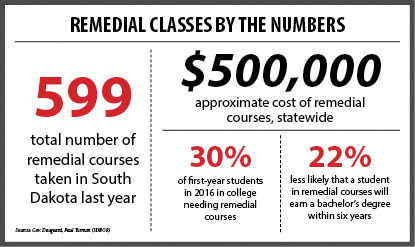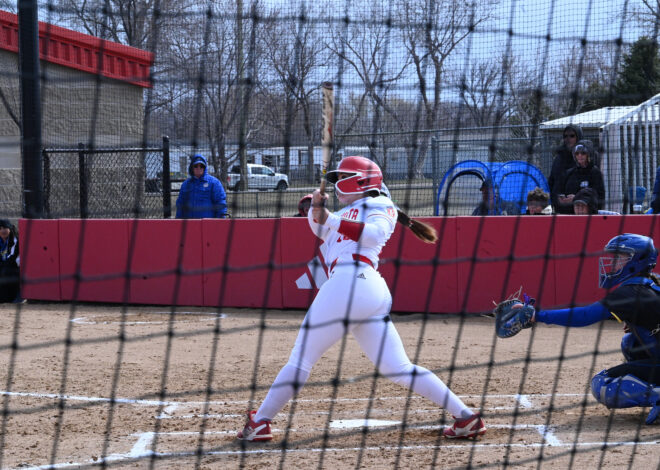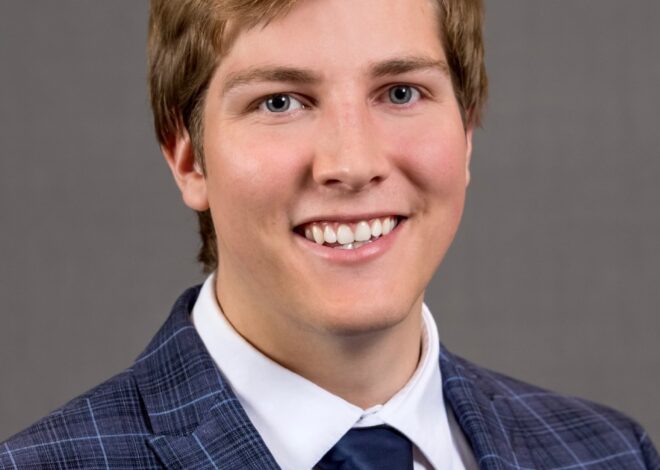
Almost one in three South Dakota first-years must take a remedial course
In South Dakota, roughly 30 percent of all first-year college students are deficient in their mastery of math or English or both, in many cases. Governor Daugaard addressed this issue in his State of the State Address, calling students’ unpreparedness for college coursework a “persistent problem.”
Having to take remedial courses, Daugaard said, is a “lose-lose,” because students are forced to pay to learn material they should’ve learned in high school, and the courses don’t count as college credit.
Universities struggle with this as well, because the odds of graduation are poorer for any student taking remedial courses, he said.
There’s a program provided by the state that helps identify subjects that students might need some remediation in before entering college, called the Accuplacer test. Launched in fall of 2013, the intent of the Accuplacer is to tackle the problem while a student is still in high school, thus eliminating the need for costly remedial courses.
Paul Turman, vice president of academic affairs of the South Dakota Board of Regents, said the Accuplacer test is much more than just an assessment – it’s a whole program for high school students.
“Those students are encouraged to take an Accuplacer diagnostic, and then that diagnostic basically builds a set of modules for them to work through,” Turman said. “Scores are used to determine whether they’re ready to go into college-bearing courses.”
Ideally, a student who successfully completes the Accuplacer system can avoid having to pay for a remedial math or English course in college.
Last year, however, only 154 high school students in South Dakota took the Accuplacer test, and of those, only 100 went on to take the final Accuplacer assessment. Daugaard made clear his frustration with the small number of students taking advantage of the program.
“Most students who needed this Accuplacer assessment didn’t take it,” Daugaard said in his speech. “And how do we know that? Because this past fall, just months ago, at our state universities, 599 remedial courses were required for new freshmen from South Dakota high schools. That’s 599 remedial courses, at about $1,000 each, totaling over half a million dollars in expense. Money our students paid, when the state has a free program, not being used.”
Daugaard said state high schools have been too slow in adopting Accuplacer. Of 150 school districts in South Dakota, 108 didn’t offer Accuplacer to students, he said.
While Daugaard said he’s hopeful that more school districts will start to use Accuplacer, Turman said the state is doing what it can to get students to take advantage of it.
Despite the fact that the overall percentage of students needing remedial courses has risen over the past year, Turman said he’s encouraged by the work being done by South Dakota’s Opportunity Scholarship program, which requires students to take a certain set of courses in high school.
For students who do end up in remedial courses, however, the outlook is somewhat less bright than students who don’t take the courses.
“If you are a student who comes in needing remedial, the first-year to second-year retention rates drop by almost 12 percent,” Turman said.
Over the following six years, there’s a 22 percent higher chance a student will fail to complete a degree, Turman said.
Math can be a troubling issue for incoming first-year students, Turman said, because South Dakota high schools only require three years of math, concluding their junior year. This means that many high schoolers don’t take any math classes during their senior year.
This “gap” year in math learning could be bridged by requiring South Dakota high school students to take a fourth year of math, Turman said, but such a requirement could take a long time to develop.
While math isn’t required in each year of South Dakota high schools, English is. Turman cited this as a possible explanation for why English remediation rates are lower than math.
Dan Van Peursem, chair of USD’s math department, said there may be a cultural reason behind the number of students that arrive at college unprepared for college-level math.
“We put a big social stigma (on math),” Van Peursem said. “I mean, it’s totally OK to say, ‘I hate math, I stink at math,’ whereas in real life, you’re not going to go to a party and say, ‘You know, I stink at English, I stink at grammar, I hate reading, I can’t read.’ It’s kind of a shame to admit you can’t read, but it’s perfectly OK, and actually kudos to you, if you can’t do math. So I think there’s part of a social acceptance that doesn’t help us any.”
Patricia DiMond, an instructor at USD who teaches remedial English courses, said students in her class have their strong suits, as well as areas where they need more practice.
“I have a variety of students coming in with a variety of skills,” DiMond said. “Some of them have never written a research paper, some of them have written multiple research papers but the last time they had anything to do with grammar was fourth grade, so their grammar and usage is all over the place.”
DiMond added that not all high school educations are created equal in South Dakota – some students come from high schools that are understaffed, particularly in some reservation areas.
“Sometimes it’s the institution, sometimes the teachers just do not have time to teach writing the way they would like to, other times it’s the curriculum,” DiMond said.
The purpose of placing a student in a remedial course, DiMond added, isn’t just to bridge a gap in subject matter – it’s also to help them transition to college courses in general.
“Sometimes they’re not prepared for the demands that college makes of them,” DiMond said. “Part of this remedial course is helping them to be successful in college, by teaching them to read a syllabus, to use it as a calendar for what they have to do each day, to keep track of their work, to manage their time.”
Some day, Turman hopes, the conversation of student readiness for college will be in the past, because more students will be ready for the transition.
“We’ll keep looking for policy solutions so that at some point, USD is not in the business of doing remediation for its students at all,” Turman said.


